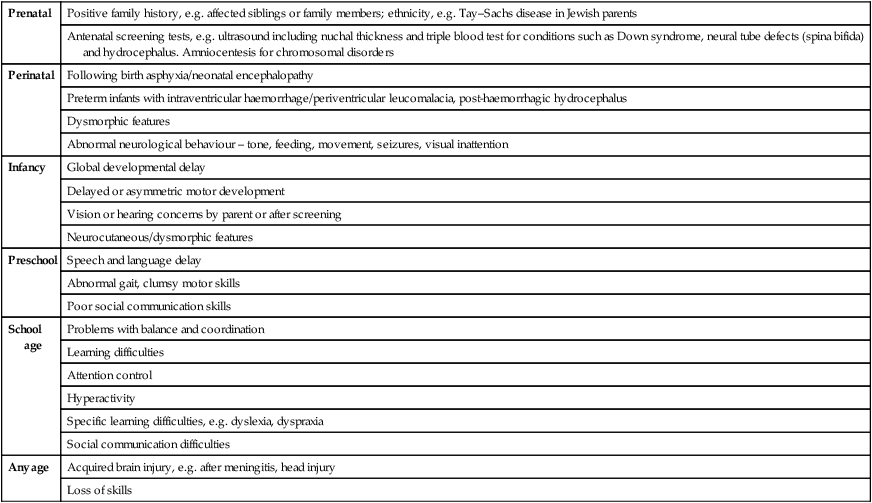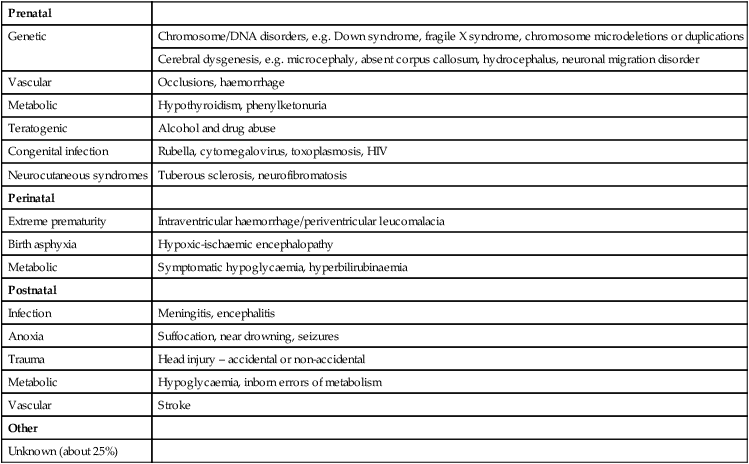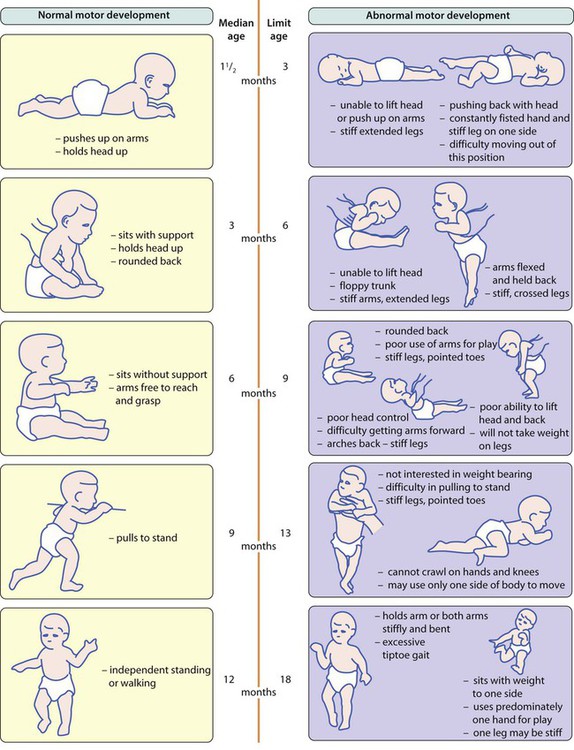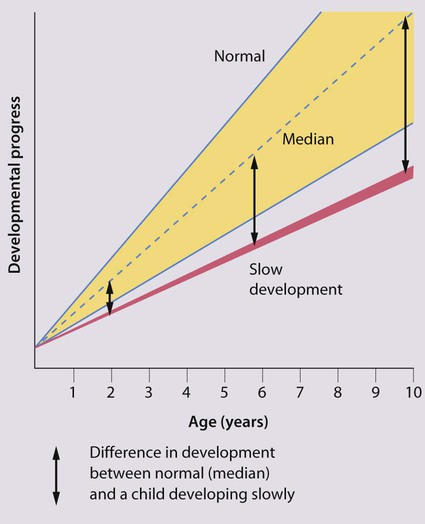Developmental problems and the child with special needs
Any child whose development is delayed or disordered needs assessment to determine the cause and management. Neurodevelopmental problems present at all ages, with an increasing number now recognised antenatally (Table 4.1). Many are identified in the neonatal period because of abnormal neurology or dysmorphic features. During infancy and early childhood, problems often present at an age when a specific area of development is most rapid and prominent, i.e. motor problems during the first 18 months of age, speech and language problems between 18 months and 3 years and social and communication disorders between 2 and 4 years. Abnormal development may be caused not only by neurodevelopmental problems (Table 4.2) but also by ill health or if the child’s physical or psychological needs are not met.
Table 4.1
Features that may suggest neurodevelopmental concerns by age
| Prenatal | Positive family history, e.g. affected siblings or family members; ethnicity, e.g. Tay–Sachs disease in Jewish parents |
| Antenatal screening tests, e.g. ultrasound including nuchal thickness and triple blood test for conditions such as Down syndrome, neural tube defects (spina bifida) and hydrocephalus. Amniocentesis for chromosomal disorders | |
| Perinatal | Following birth asphyxia/neonatal encephalopathy |
| Preterm infants with intraventricular haemorrhage/periventricular leucomalacia, post-haemorrhagic hydrocephalus | |
| Dysmorphic features | |
| Abnormal neurological behaviour – tone, feeding, movement, seizures, visual inattention | |
| Infancy | Global developmental delay |
| Delayed or asymmetric motor development | |
| Vision or hearing concerns by parent or after screening | |
| Neurocutaneous/dysmorphic features | |
| Preschool | Speech and language delay |
| Abnormal gait, clumsy motor skills | |
| Poor social communication skills | |
| School age | Problems with balance and coordination |
| Learning difficulties | |
| Attention control | |
| Hyperactivity | |
| Specific learning difficulties, e.g. dyslexia, dyspraxia | |
| Social communication difficulties | |
| Any age | Acquired brain injury, e.g. after meningitis, head injury |
| Loss of skills |

Table 4.2
Conditions which cause abnormal development and learning difficulty
| Prenatal | |
| Genetic | Chromosome/DNA disorders, e.g. Down syndrome, fragile X syndrome, chromosome microdeletions or duplications |
| Cerebral dysgenesis, e.g. microcephaly, absent corpus callosum, hydrocephalus, neuronal migration disorder | |
| Vascular | Occlusions, haemorrhage |
| Metabolic | Hypothyroidism, phenylketonuria |
| Teratogenic | Alcohol and drug abuse |
| Congenital infection | Rubella, cytomegalovirus, toxoplasmosis, HIV |
| Neurocutaneous syndromes | Tuberous sclerosis, neurofibromatosis |
| Perinatal | |
| Extreme prematurity | Intraventricular haemorrhage/periventricular leucomalacia |
| Birth asphyxia | Hypoxic-ischaemic encephalopathy |
| Metabolic | Symptomatic hypoglycaemia, hyperbilirubinaemia |
| Postnatal | |
| Infection | Meningitis, encephalitis |
| Anoxia | Suffocation, near drowning, seizures |
| Trauma | Head injury – accidental or non-accidental |
| Metabolic | Hypoglycaemia, inborn errors of metabolism |
| Vascular | Stroke |
| Other | |
| Unknown (about 25%) |

The site and severity of brain damage influences the clinical outcome, i.e. whether specific or global developmental delay, learning and/or physical disability.
When performing a clinical examination on a young child with a developmental problem:
• Ask the parent what their child can and cannot do. Start at a level below what a child is likely to be able to do to retain confidence of the parent and child.
• Observe the child from the first moment seen.
• Make it fun. Your examination should be perceived as a game by the child, although they may not always follow your rules.
• Toys to use are cubes, a ball, car, doll, pencil, paper, pegboard, miniature toys, picture book. Adapt their use to the child.
• Formulate a developmental picture in terms of gross motor; vision and fine motor; hearing, speech and language; and social, emotional and behaviour. As you become more confident you will screen all these skills simultaneously.
• At the end of developmental screening you should be able to describe what a child is able to do and what the child cannot do, if the abilities are within normal limits for age and, if not, which developmental fields are outside the normal range.
• Clinical signs to look for that may aid diagnosis or guide investigation are:
– patterns of growth: height, weight, head circumference with centile plotting
– dysmorphic features: face, limbs, body proportions, cardiac, genitalia
– skin: neurocutaneous stigmata, injuries, cleanliness
– central nervous system examination: abnormal posture/symmetry, wasting, power and tone, deep tendon reflexes, clonus, plantar responses, sensory examination, cranial nerves
– cardiovascular examination: abnormalities are associated with many dysmorphic syndromes
– visual function and ocular abnormalities
– hearing: by questioning parents about hearing and language development and checking if neonatal hearing screening was done
– patterns of mobility, dexterity, hand dominance, communication and social skills, general behaviour
Many examination findings can be predicted from observation of functional skills.
Abnormal development – key concepts
The terminology can be confusing, but:
• Delay – implies slow acquisition of all skills (global delay) or of one particular field or area of skill (specific delay), particularly in relation to developmental problems in the 0–5 years age group
• Learning difficulty – used in relation to children of school age and may be cognitive, physical, both or relate to specific functional skills
The following are agreed definitions:
• Impairment – loss or abnormality of physiological function or anatomical structure
• Disability – any restriction or lack of ability due to the impairment
• Disadvantage – this results from the disability, and limits or prevents fulfilment of a normal role. It is situationally specific; a child with a learning disability may for example be a good skier or enjoy swimming.
The pattern of abnormal development (global or specific) can be categorised as (Fig. 4.1):
The severity can be categorised as:
Other features of developmental delay are:
• The gap between normal and abnormal development becomes greater with increasing age and therefore becomes more apparent over time (Fig. 4.2).
• It may be the presentation of a wide variety of underlying conditions (Table 4.2).
• The site and severity of brain damage influences the clinical outcome, i.e. whether there will be specific or global developmental delay, learning and/or physical disability.
• It may be genetic, with important implications for the family.
• There is a wide age band across which it can be normal to achieve a developmental skill. Limit ages denote beyond the normal range.
The choice of investigations to identify the cause is influenced by the child’s age, the history and clinical findings (Table 4.3). In some children, no cause can be identified even after extensive investigation.
Table 4.3
Investigations or assessment to consider for developmental delay
| Cytogenetic | Chromosome karyotypea |
| Fragile X analysisa | |
| DNA FISH analysis, e.g. for chromosome 7, 15, 22 deletions, CGH microarray (comparative genomic hybridisation), telomere screen | |
| Metabolic | Thyroid function tests, liver function tests, bone chemistry, urea and electrolytes, plasma amino acidsa |
| Creatine kinase, blood lactate, VLCFA (very long chain fatty acids), ammonia, blood gases, white cell (lysosomal) enzymes, urine amino and organic acids, urine mucopolysaccharides (GAG) and oligosaccharide screen, urine reducing substances, lead levels, urate, ferritin, biotinidase | |
| Maternal amino acids for raised phenylalanine | |
| Infection | Congenital infection screen |
| Imaging | Cranial ultrasound in newborn |
| CT and MRI brain scans | |
| Skeletal survey, bone age | |
| Neurophysiology | EEG (for seizures and can be specific for some progressive neurological disorders and syndromes) |
| Nerve conduction studies, EMG, VEP (visual evoked potentials), ERG (electroretinogram) | |
| Histopathology/histochemistry | Nerve and muscle biopsy |
| Other | Hearinga |
| Visiona | |
| Clinical genetics | |
| Cognitive assessment | |
| Therapy assessment – physiotherapy, occupational therapy and speech and language therapy | |
| Child psychiatry | |
| Dietician | |
| Nursery/school reports |

Developmental delay
Global developmental delay (also called early developmental impairment) implies delay in acquisition of all skill fields (gross motor, vision and fine motor, hearing and speech, and language and cognition, social/emotional and behaviour). It usually becomes apparent in the first 2 years of life. Global developmental delay is likely to be associated with cognitive difficulties, although these may only become apparent several years later. The presence of global developmental delay should always generate investigation into a possible cause such as those listed in Table 4.2. When children become older and the clinical picture is clearer, it is more appropriate to describe the individual difficulties such as learning disability, motor disorder and communication difficulty, rather than using the term global developmental delay.
Abnormal motor development
Causes of abnormal motor development include:
• central motor deficit e.g. cerebral palsy
• congenital myopathy/primary muscle disease
• spinal cord lesions, e.g. spina bifida
• global developmental delay, as in many syndromes or of unidentified cause.
Late walking (>18 months old) may be caused by any of the above but also needs to be differentiated from children who display the normal locomotor variants of bottom-shuffling or commando crawling (see Ch. 3), where walking occurs later than with crawlers.
Cerebral palsy (CP)
Clinical presentation
• Abnormal limb and/or trunk posture and tone in infancy with delayed motor milestones (Fig. 4.3); may be accompanied by slowing of head growth

• Feeding difficulties, with oromotor incoordination, slow feeding, gagging and vomiting
In CP, primitive reflexes, which facilitate the emergence of normal patterns of movement and which need to disappear for motor development to progress, may persist and become obligatory (see Ch. 3).
The diagnosis is made by clinical examination, with particular attention to assessment of posture and the pattern of tone in the limbs and trunk, hand function and gait. There are three main clinical subtypes: spastic (90%), dyskinetic (6%) and ataxic (4%). A mixed pattern may occur. Functional ability is described using the Gross Motor Function Classification System (Table 4.4).
Table 4.4
Gross Motor Function Classification System (GMFCS)
| Level I | Walks without limitations |
| Level II | Walks with limitations |
| Level III | Walks using a handheld mobility device |
| Level IV | Self-mobility with limitations; may use powered mobility |
| Level V | Transported in a manual wheelchair |








